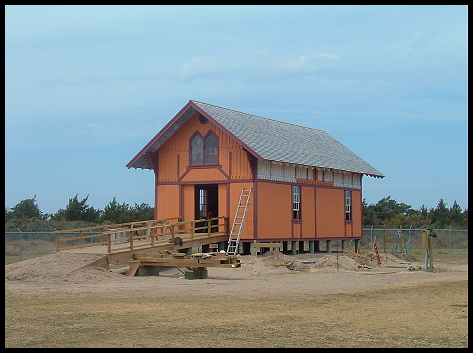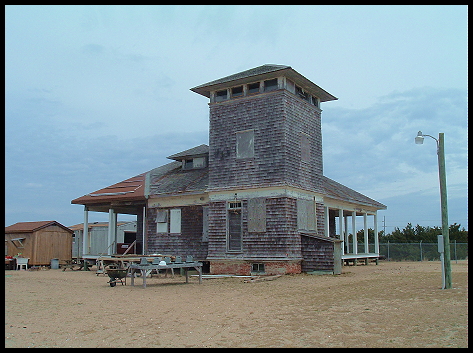In 1874, the US Life-Saving Service established a life-saving station north of what is today known as Avon Village. The original station building was an 1874-Type building, which served until 1904 when a larger, Southern Pattern-Type building was added, expanding the station.
The station continued to serve the needs of mariners until the Coast Guard no longer needed it. They were decomissioned in 1954 and were later turned over to the National Park Service. To protect the buildings from the ocean and storms the buildings were later moved to the west side of Hwy 12.
For more information on the station:
The Stabilization Process of the Little Kinnakeet Life-Saving Station
The National Parks Service is currently working to stabilize the buildings at the Little Kinnakeet Life-Saving Station. While the NPS has only received enough funding to stabilize and ensure the structural integrity of the buildings, funding for full restoration of the buildings is still being sought.
As part of the stabilization process, the 1874-type station has been lifted off of its concrete foundation that is has rested upon for many years and is now supported by a series of wood pilings that elevate it off the ground. The concrete foundation has been removed, and once the stabilization process is complete on both buildings, sand will be brought in and added to the ground around the buildings, changing the grade of the land in an effort to protect the buildings from storms and the ocean.
Inside the 1874-type station, all of the damaged woodwork supporting the structure has been removed and replace with new lumber. All original woodwork that is in good condition has been kept and great pains have been taken incorporate the new lumber into the building, keep with its original construction. Outside the building, the new brownish paint job returns the station to the look it had in 1892 when the summer kitchen was added. A portion of the east side of the station that was not original to the building has also been removed. New (and quite solid) boat doors have been added to the front of the building in keeping with the original design of the station. Once the roof has been replaced and the interior work is complete, the decorative wooden scroll panels will be added back to the building.
Once work to the 1874 station is complete, work will start to stabilize the 1904 Southern Pattern-Type Station. Currently, this building is being used to for storage of equipment and artifacts from the 1874 building, but some work has been done to ensure the stability of this structure. A series of studs have been erected inside the watchtower, specifically in the room below the watch room and some weatherproofing has been done to protect the interior from further damage.
While the future for these historic buildings are not 100% clear, the current plans are to paint the 1904 building yellow, its original color. Future goals for the buildings include a complete restoration, including replacing the cupola atop the 1874 station and eventually opening the building for the public to enjoy as part of a museum, teaching the history of the stations and history of the Outer Banks.
For more photos of these building, including past photos and photos of work being done to the buildings, follow the buttons below.



